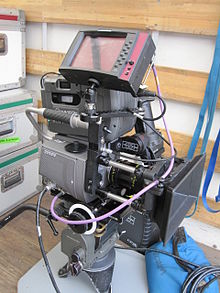- Digital movie camera
-
Contents
Digital movie cameras for digital cinematography are typically purpose-designed professional video cameras designed for the capture of high optical resolution, high dynamic range imagery. Different digital movie cameras output a variety of different acquisition formats. Cameras designed for domestic use have also been used for some low-budget independent productions.
Professional
There are a number of video cameras on the market designed specifically for high-end digital cinematography use. These cameras typically offer relatively large sensors, selectable frame rates, recording options with low compression ratios or in some cases with no compression, and the ability to use high-quality optics. Some of the cameras are expensive and some are only available to rent.
Some professional digital cinema cameras include:
- Arriflex D-20, Arriflex D-21, Arri Alexa
- Sony CineAlta
- Dalsa Origin
- Panavision Genesis
- Red One
- Panasonic VariCam
'Prosumer' and consumer cameras
Independent filmmakers have also pressed low-cost consumer and prosumer cameras into service for digital filmmaking. Though image quality is typically much lower than what can be produced with professional digital cinematography cameras, the technology has steadily improved, most significantly in the last several years with the arrival of high-definition cameras in this market. These inexpensive cameras are limited by their relatively high compression ratios, their small sensors, and the quality of their optics. Many have integrated lenses which cannot be changed.
Standard definition
MiniDV is the predominant standard definition consumer video acquisition format. Steven Soderbergh used the popular Canon XL2 MiniDV camera while shooting Full Frontal. The Danny Boyle directed British horror film, 28 Days Later was also shot on MiniDV using the Canon XL1S, albeit with traditional Panavision 35mm film lenses. One of the first MiniDV cameras used on a feature film was the Sony VX-1000, which was used to shoot Spike Lee's Bamboozled.
In 2002, Panasonic released the AG-DVX100, which was the first affordable camcorder to support progressive scan at 24 frames per second, duplicating the motion characteristics of film and allowing for easier transfers to film. This feature made the camera extremely popular with low-budget filmmakers.
High definition
Sony, JVC, Canon and other vendors have brought high-definition video acquisition to the consumer and prosumer markets with the HDV format. Though it is a high-definition format, HDV video can be recorded to MiniDV tapes, which are inexpensive and widely available. HDV cameras are sold with a wide range of capabilities. Many support progressive shooting modes, and some have sensors with full 1920x1080 resolution (though the HDV format itself can only record 1440x1080 pixels in rectangle pixels, and DVCPRO HD only records at 1280x1080 or 960x720). In addition, some Canon and JVC HDV camcorders have the ability to use high-quality interchangeable lenses, rather than the fixed lenses that are included with most prosumer cameras.
The Canon EOS 5D Mark II is a "full-frame" still camera capable of capturing motion in "Movie mode" with 12 minutes of full HD at 1920x1080p at 30 or 24 frames per second, or 30 minutes of SDTV at 640x480 resolution at 30 and 24 frames per second, for up to 4 GB. Film makers are pressing this camera into service as a low-cost way to shoot motion. Many more HD capable still camera models have been marketed by several manufacturers.
The Canon EOS 7D was used to shoot the independent horror film Marianne[1]
References
- ^ Filip, Tegsdedt. "DSLR Feature Film List". http://www.dvxuser.com/V6/showthread.php?198927-DSLR-Feature-Film-List. Retrieved 27 May 2011.
External links
Categories:- Film and video technology
- Digital movie cameras
Wikimedia Foundation. 2010.


